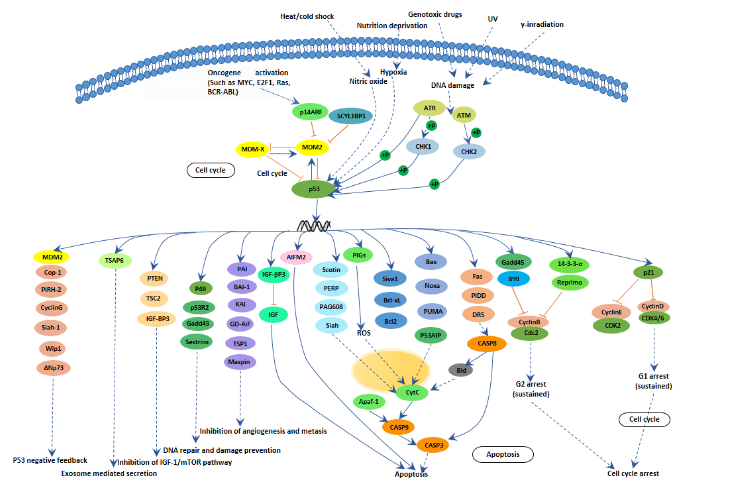p53 signaling pathway
Based on Luminex technology platform, Creative Proteomics provides analysis services for key targets of p53 signaling pathway.
The p53 pathway is a key factor that helps to conserve the stability of the genome by preventing mutations caused by cellular stress or DNA damage. p53 stabilizes the genome by interacting with a number of signal transduction pathways in the cell to regulate a wide variety of cellular processes including apoptosis, senescence, cell cycle arrest, differentiation, and DNA repair and replication. p53 is activated in response to a number of stress stimuli, including DNA damage, oxidative stress and activated oncogenes, which are transmitted by post-translational modifications. Activated p53 functions effectively as a transcription factor and can then induce transcription of several genes. Mutations in p53 are associated with genomic instability and an increased susceptibility to cancer, particularly cervical and colorectal cancers, and it is believed that more than half of all cancers may involve p53-inactivating mutations. Additionally, certain DNA viruses, such as papillomavirus, can also inactivate the protein.

The p53 pathway is composed of a network of genes and their products that are targeted to respond to a variety of intrinsic and extrinsic stress signals that impact upon cellular homeostatic mechanisms that monitor DNA replication, chromosome segregation and cell division. In response to a stress signal, the p53 protein is activated in a specific manner by post-translational modifications, and this leads to either cell cycle arrest, a program that induces cell senescence or cellular apoptosis. In this way, a variety of intrinsic or extrinsic stresses that would result in a loss of fidelity in DNA replication, genome stability, cell cycle progression or faithful chromosome segregation can be accommodated or, alternatively, the clone of cells with these defects eliminated from the body.
In addition to these responses to cellular stress at the single-cell level, the p53 pathway in a cell communicates with neighboring cells by secreting a series of proteins that may alter the cellular environment. P53-regulated and p53-secreted proteins may alter the extracellular matrix and influence angiogenic signals in a localized region of a tissue. After DNA damage in a cell, the p53 pathway produces a set of proteins that can aid directly in DNA repair processes. Finally, the activation of the p53 protein and its network of genes sets in motion an elaborate process of autoregulatory-positive or autoregulatory-negative feedback loops, which connect the p53 pathway to other signal transduction pathways in the cell, and through this broader communication permits the completion or the reversal of the p53 programmed responses to stress.
Our detectable targets:
| ATM | ATR | CHK2 | CHK1 | MDM2 | MDM-k |
| p14 | p53 | Cop-1 | PIRH-2 | CyclinG | Siah-1 |
| Wip1 | ANp73 | TSAPS | PTEN | TSC2 | IGF-BP3 |
| p53R2 | PAI | BAI-1 | KAI | GD-Aif | TSP1 |
| IGF | IGF-BP3 | PIGs | Bax | PUMA | Siah |
| Fas | p53AIP | DRS | CASPS | Cdc2 | CDK2 |
| p21 |
Technology platform
We provide Luminex technology for Rho-ROCK signaling pathway analysis.
Luminex technology is a multifunctional liquid phase analysis platform developed on the basis of colored microspheres, laser technology, applied fluidics and high-speed digital signal processing technology. The core is to encode polypropylene microspheres or magnetic microspheres with fluorescent dyes. By adjusting the different ratios of the two fluorescent dyes, up to 100 microspheres with different fluorescence spectra can be obtained. Each kind of microspheres is covalently cross-linked. Capture antibodies against specific antigens.
p53 stabilizes the genome by interacting with many signal transduction pathways in cells, and plays a major role in regulating apoptosis, senescence, cell cycle arrest, differentiation, and DNA repair and replication.
In addition to Luminex Multiplex Assay, Enzyme-linked immunosorbent assay (ELISA), Flow cytometry (FACS analysis) technology can also be provided to meet other customer needs.
Advantages of Rho-ROCK signaling pathway detection:
- High-throughput and high-speed: Each microsphere is used as a separate test body, which can perform a large number of biological tests at the same time. It only needs 10~201 samples to test up to 100 indicators at a time, and the fastest can reach 10,000 tests /hour.
- High flexibility: specific probes, antigens or antibodies can be connected to the microspheres to meet the needs of different customers.
- Good repeatability: similar homogeneous reaction mode, each indicator has 1000-5000 reaction units, and the median value of 100 analysis is taken.

Application of our service:
- To study the effect of each virus on p53 signaling pathway
- To study the regulation mechanism of p53 signal pathway in disease
- To study the effects of drugs or therapies on p53 signaling pathways
Creative Proteomics has developed a signal pathway target detection platform. We are not limited to providing p53 signal path detection services, but can also provide other signal path detection services. If you want to detect other targets, please contact us and we will customize the service for you. Look forward to working with you.
References:
- Harris, S., Levine, A. The p53 pathway: positive and negative feedback loops. Oncogene, 2019, 24: 2899–2908.
- Dennis Timmerman, Tessa Remmers, et al. Mechanisms of TP53 Pathway Inactivation in Embryonic and Somatic Cells—Relevance for Understanding (Germ Cell) Tumorigenesis. Int. J. Mol. Sci, 2021, 22(10): 5377.



